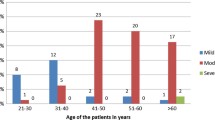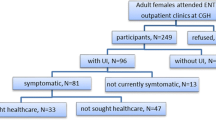Abstract
A territory-wide telephone survey was conducted in Hong Kong to assess the prevalence, knowledge, and treatment-seeking behaviour of Chinese women with urinary incontinence, using validated Chinese version of Urogenital Distress Inventory (UDI-6) and Incontinence Impact Questionnaire (IIQ-7). Women, 540, aged between 17 to 77 years were interviewed. Of the respondents, 40.8% reported stress urinary incontinence, 20.4% had urge incontinence and 15.9% had mixed incontinence. Among these, 16.0% reported quality of life impairment; 9.3% felt frustrated with low morale, and 15.2% had nervous and anxiety problems. However, as many as 78.3% of the respondents did not know that stress urinary incontinence is a disease entity, and 60.6% thought that leakage of urine was a normal aging process. For those respondents having stress urinary incontinence, the first treatment of choice was physiotherapy. The second choice was medication, and surgical treatment was the last option. Respondents with stress urinary incontinence showed higher education level.
Similar content being viewed by others
References
Brieger GM, Yip SK, Chung TKH (1996) The prevalence of urinary dysfunction in Hong Kong Chinese women. Obstet Gynecol 88:1041–1044
Ip WY, Chien WT, Chan CL (2003) Childbirth expectations of Chinese first-time pregnant women. J Adv Nurs 42:151–158
Norton PA (1990) Prevalence and social impact of urinary incontinence in women. Clin Obstet Gynecol 33:295–297
Norton PA, MacDonald LD, Sedgwick PM, Stanton SL (1988) Distress and delay associated with urinary incontinence, frequency and urgency in women. Br Med J 297:1187–1189
Breakwell SL, Walker SN (1988) Differences in physical health, social interaction, and personal adjustment between continent and incontinent homebound aged women. J Commun Health 5:19–31
Dugan E, Cohen SJ, Bland DR, Preisser JS, Davis CC, Suggs PK, McGann P (2000) The association of depressive symptoms and urinary incontinence among older adults. J Am Geriatr Soc 48(4):413–416
Harris A (1999) Impact of urinary incontinence on the quality of life of women. Br J Nurs 8(6):375–380
Kelleher CJ, Cardozo LD, Khullar V, Salvatore S (1997) A new questionnaire to assess the quality of life of urinary incontinent women. Br J Obstet Gynaecol 104:1374–1379
Uebersax JS, Wyman JF, Shumaker SA, McClish DK, Fantl JA (1995) Short forms to assess life quality and symptom distress for urinary incontinence in women: the incontinence impact questionnaire and the urogenital distress inventory. Continence Program for Women Research Group. Neurourol Urodyn 14(2):131–139
Shumaker SA, Wyman JF, Uebersax JS, McClish D, Fantl JA (1994) Health-related quality of life measures for women with urinary incontinence: the Incontinence Impact Questionnaire and the Urogenital Distress Inventory. Continence Program in Women (CPW) Research Group. Qual Life Res 3(5):291–306
Yip SK, Chung TKH (2003) Treatment-seeking behavior in Hong Kong Chinese women with urinary symptoms. Int Urogynecol J 14:27–30
Census and Statistics Department (2004) Hong Kong Government
Cable and Wireless HKT (2004) Five-year statistics
Thomas TN, Plymat KR, Blannin J, Meade TW (1980) Prevalence of urinary incontinence. Br Med J 281:1243–1245
Jolleys JV (1988) Reported prevalence of urinary incontinence in women in general practice. Br Med J 296:1300–1302
Pang MW, Leung HY, Chan LW, Yip SK (2005) A study on Hong Kong incontinent women’s quality of life. Hong Kong Med J 11:158–163
Hunskaar S, Lose G, Sykes D, Voss S (2004) The prevalence of urinary incontinence in women in four European countries. BJU Int 93:324–330
Dallosso MM, McGrother CW, Matthews RJ et al (2003) The association of diet and other lifestyle factors with overactive bladder and stress incontinence: a longitudinal study in women. BJU Int 92:69–77
Bump RC, McClish DK (1992) Cigarette smoking and urinary incontinence in women. Am J Obstet Gynecol 167:1213–1218
Sampselle CM, Palmer MH, Boyington AR et al (2004) Prevention of urinary incontinence in adults population-based strategies. Nursing Research 53:61–68
Acknowledgement
The authors would like to thank Professor Ka-Ying Wong, Director, Telephone Survey Research Laboratory, Hong Kong Institute of Asia-Pacific Studies, The Chinese University of Hong Kong, for his technical assistance in the telephone survey.
Author information
Authors and Affiliations
Corresponding author
Rights and permissions
About this article
Cite this article
Wong, T., Lau, B.YT., Mak, HL. et al. Changing prevalence and knowledge of urinary incontinence among Hong Kong Chinese women. Int Urogynecol J 17, 593–597 (2006). https://doi.org/10.1007/s00192-006-0072-3
Received:
Accepted:
Published:
Issue Date:
DOI: https://doi.org/10.1007/s00192-006-0072-3




